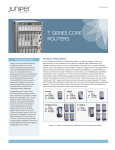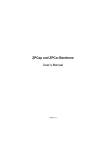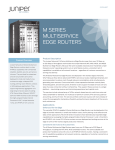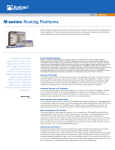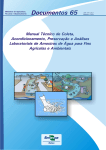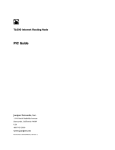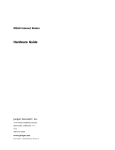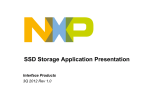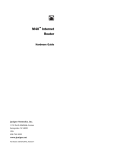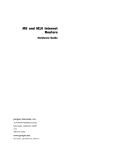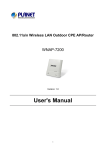Download Juniper CBL-TXP-004M fiber optic cable
Transcript
DATASHEET T SERIES CORE ROUTERS Including JCS1200 CONTROL SYSTEM Product Overview Today’s connected society depends on telecom infrastructure, and service Product Description Core networks must scale in multiple dimensions—on the forwarding, control, and service planes. A true multiservice core requires a reliable, high-performance, and flexible architecture that can carry a wide breadth of services over a common providers require solutions with new IP/MPLS infrastructure. This enables service providers to deliver stringent service-level dimensions of flexibility and scale. agreements (SLAs) while minimizing both capital and operational expenditures. The Juniper In a networked economy, business Networks® T Series Core Router family—T320, T640, T1600, TX Matrix and TX Matrix Plus— performance is impacted by the quality provides the ingredients for high-end and core networks of the future, especially when of connectivity. Carriers must translate controlled by the Juniper Networks JCS1200 Control System. Figure 1 illustrates the industry- this dependence into profitability, which leading scaling characteristics of T Series on the forwarding and control planes. means finding new ways to supplement traditional revenue, developing 100G/slot alternative services, and evolving T1600 TX Matrix Plus business models to the changing Qty. Port Type Qty. Port Type network landscape. 160 16 8 10G 40G 100G 640 64 32 10G 40G 100G T Series Core Routers, in conjunction with the JCS1200, provide a unique solution that’s flexible and robust 40G/slot enough to tackle these new challenges. JCS1200, the industry’s T640 only independent control plane scaling Qty. Port Type system, brings virtualization to the core 32 8 10G 40G of the network. T Series, with the TX Matrix Plus, provides transport scale up to 6.4 Tbps. The result is the world’s most flexible routing system, enabling JCS1200 Single Chassis TX Matrix Qty. Port Type 128 32 10G 40G Multi Chassis Figure 1: T Series Scaling By Slot and Chassis – All Routers are Controlled by JCS1200 customers to build scalable networks Juniper Networks high-end routing products provide the leading features demanded by that adapt to changing business models. service providers today to handle the massive growth in core bandwidth requirements. These features include MPLS Differentiated Services (DiffServ-TE), point-to-multipoint label-switched paths, nonstop routing and in-service software upgrades (ISSUs), hierarchical MPLS, and service delivery coupling with the Juniper Networks JCS1200 and the Partner Solution Development Platform (PSDP). 1 Table 1: Juniper Networks T Series Scaling Characteristics Platform Throughput Maximum Forwarding Rate Rack Space 10-Gigabit Ethernet Density Fully Redundant Hardware Multichassis Capable T320 320 Gbps 385 Mpps 1/3 rack (19 in) 16 Yes No T640 640 Gbps 770 Mpps 1/2 rack (19 in) 32 Yes Yes T1600 1.6 Tbps 1.92 Billion pps 1/2 rack (19 in) 80 (line rate) Yes Yes 160 (oversubscribed) TX Matrix with 4 x T640 2.5 Tbps 3 Billion pps 3 racks 128 Yes Yes TX Matrix Plus with 4 x T1600 6.4 Tbps 7.68 Billion pps 3 racks (1 x 23 in for TX Matrix Plus, 2 x 19 in for T1600) 320 (line rate) Yes Yes 640 (oversubscribed) T Series routers enable service providers to deliver stringent QoS Combined with its 320-Gbps throughput and its 385-Mpps and meet SLAs for multiservice transit and IP services. In addition, forwarding rate, the T320 delivers non-blocking, any-to-any Juniper’s industry-leading IP/MPLS capabilities guarantee that the connectivity and uncompromising performance with numerous service level and performance of critical services are maintained, features enabled across multiple interfaces. Its density, speed, while extending the effective lifespan of legacy network assets. and size make it ideal for small to medium cores, as well as The T Series is ideal for creating routed infrastructures that must for aggregating access routers, peering, and metro Ethernet scale to meet constantly growing Internet traffic for all varieties applications. of applications. Furthermore, capacity-based power consumption for all T Series routers is the lowest in the industry. The following table illustrates the scaling characteristics of the T Series family. T640 Routing Node At 19 inches wide and a half-rack in height, the Juniper Networks T640 Core Router addresses the need for highly scalable, high- JCS1200 performance core routing at a fraction of the size of competitive The Juniper Networks JCS1200 Control System is the industry’s offerings. Each of the eight slots in the T640 delivers 40 Gbps first purpose-built, control plane scaling platform, providing with the ability to scale well beyond that capacity, fulfilling the high-power processing with a multi-CPU, multi-core server-class need for the high-bandwidth services of today and tomorrow. computing environment. With scalable memory and storage media, JCS1200 provides up to 12 routing engines in a compact one-quarter rack chassis. The T640 supports up to 8 OC-768c/STM-256 ports, 32 10-Gbps ports (10-Gigabit Ethernet or OC-192/STM-64), 128 OC-48c/ STM-16 ports, and an industry-leading 320 Gigabit Ethernet JCS1200 helps operators consolidate networks (corporate and ports. It delivers up to 640 Gbps of capacity with the ability to residential) and nodes (core and aggregation) onto a single forward up to 770 million packets per second (Mpps). The T640 simplified infrastructure. Key applications for the JCS1200, also supports lower speed interfaces for organizations looking when used in conjunction with T Series routers, include network to combine high-speed core routing with dedicated access virtualization, and scalable, high-performance route reflectors. aggregation in a single platform. The result is high CapEx and OpEx savings, secure administrative isolation between services, the rapid introduction of new services, and unprecedented operational flexibility. T1600 Routing Platform Also at 19 inches wide and a half-rack in height, the multichassiscapable Juniper Networks T1600 Core Router addresses the need T320 Router for highly scalable, high-performance core routing at a fraction The Juniper Networks T320 Core Router is designed for use of the size of competitive offerings. The T1600 delivers up to 1.6 where rack space is at a premium and a wide range of interface Tbps of capacity (100 Gbps/slot) with the ability to forward up to speeds are needed. The T320 consumes one-third of a standard 1.92 billion pps. 19 inch equipment rack and uses less power for efficient small core applications. Yet the T320 router still offers unprecedented density compared to competing high-end platforms, while providing double the power efficiency. Juniper provides unique capabilities for upgrading T Series routers to accommodate the changing requirements of service providers. For example, the T640 can grow in-service into a T1600 by only replacing the power module and switch fabric. Following such an Each T320 router can support up to sixteen 10-Gbps ports upgrade, the T1600 provides more than double the capacity of (OC-192c/ STM-64 or 10-Gigabit Ethernet) while allowing lower T640, while only using fractionally more power. speed connectivity down to channelized increments within the same chassis. Power consumption is very low, requiring only 60 A at –48 VDC with 2,880 watts maximum and lower for typical configurations. 2 The packet forwarding and switching complex of a T1600 TX Matrix Plus supports 100 Gbps per slot. Current interface configurations include up to 8 100-Gigabit Ethernet ports, 16 OC-768c/STM-256 JCS1200 ports, 64 OC-192/STM-64 ports or 80/160 10-Gigabit Ethernet (line rate/oversubscribed). The T1600 also supports lower speed interfaces for those wishing to combine high-speed core routing with dedicated access aggregation in a single platform. TX Matrix and TX Matrix Plus Core Routers The TX Matrix Plus is the central switching and routing element that interconnects up to 4 T1600 chassis into a single routing entity with 32 slots and a sustainable throughput rate of up to 6.4 PSD4 PSD3 PSD1 PSD2 Tbps (7.68 billion pps). With TX Matrix Plus, operators can build systems containing up to 4 line card chassis for a total of up to T1600 320/640 10-Gigabit Ethernet (line rate/oversubscribed) ports, T1600 64 40 Gbps ports or 32 100-Gigabit Ethernet ports. Using the as video, mobile, and all corporate traffic. Both the TX Matrix and TX Matrix Plus scale gracefully as more ports are added; additional routers and slots are connected to the Peering Peering of virtual service networks for advanced partitioned services such Public Public Core Private Private 11 Core be partitioned into aggregation or edge routing, or into the support Core Private Private 2 2 Core 1 virtualization capabilities of JCS1200, this available resource can center-stage fabric over optical interfaces. Thus, TX Matrix and TX Matrix Plus expand with non-blocking bandwidth. The scalable configurations of both TX Matrix offerings increase Shared uplinks, Integrated optics, High-density 10GE, Service interfaces equipment lifespan and further reduce capital expenditures (CapEx) costs. Designed with no single point of failure, and utilizing the same system design and robust Juniper Networks Figure 2: A Virtualized, Multiservice Core Network Junos® operating system as Juniper routing platforms, these The T Series architecture allows all Junos OS features and services central switching stage platforms are designed from the ground to operate across many interface types without compromising up to achieve the highest levels of system availability. performance. All platforms are highly secure with large filter lists (hundreds of thousands of firewall filter terms) and rate limiting Architecture and Key Components to mitigate denial of service (DoS) attacks. Consistent hardware- The core network is the heart of any next-generation network or based QoS features such as deep packet classification, filtering, multiplay deployment. With the growth of distributed content and granular queuing are deployable at large scale for many in metro networks, the core network must deliver high-speed interface speeds. transport at five 9s reliability, while providing rich service delivery From its inception, Junos OS was developed for rigorous service features. The Juniper Network T Series family, with TX Matrix provider needs. For example, Junos OS is completely modular so Plus, T1600, and when used with the JCS1200, offers the premier that in the unlikely event one module experiences a problem, it is core routing option in the industry—a virtualized, ultra high- isolated to that specific section of code and does not bring down capacity core. Junos OS functionality offers the most resilient, an entire system. On the hardware side, all major components— high-performance, and flexible applications for backbone carriage including Routing Engines, Control Boards, Switch Interface of content-intensive consumer and business traffic. JCS1200 Boards (SIBs), and Power Equipment Modules (PEMs)—are functionality allows huge core routing nodes to be partitioned redundant. along service or network function lines. Figure 2 illustrates how service providers can essentially customize their routers along functional or service lines with JCS1200 and TX Matrix Plus with T1600. Backed by the industry’s widest breadth of software services, T Series Routers are designed on a foundation of IP/MPLSoptimized hardware that offers unique packet handling functionality unmatched for its flexibility and scale. The result is Four separate protected system domains (PSDs) are built with robust quality of service (QoS) for rich and scalable voice transport, JCS1200 and a TX Matrix Plus with (in this example) three T1600 video distribution, multicast replication, traffic engineering, ATM-to- routers. The PSDs (hardware logical routers) may be private or MPLS migration, and IP transit and peering services. public networks supporting any service. PSDs can span across multiple chassis, providing the most flexible architectural choices in the market. 3 Juniper’s core solutions deliver unparalleled investment protection operations. JCS1200 is a scalable, independent control plane with Physical Interfaces Cards (PICs) that are portable between that uses the power of Junos OS to create the industry’s first true Juniper Networks M Series Multiservice Edge Routers including the network convergence: consolidated POPs, virtualized network M40e, M120, M320 and the T320, T640, T1600 and multichassis functions and services, and high-performance route reflectors. systems. These PICs cover diverse interface types (ranging in speed from DS3 to 100-Gigabit Ethernet) including SONET/SDH, ATM, Gigabit Ethernet, dense wavelength division multiplexing (DWDM), and advanced security services. From dense Gigabit Ethernet and 10-Gigabit Ethernet configurations (including two 10x10 Gigabit Ethernet PICs in a single T1600 slot), to high-speed One of the key architectural choices in the T Series family of routers is the non-disruptive hardware upgrade. This is seen in the simple migration from T640 to T1600 (Figure 3) and from T1600 to the large, virtualized systems consisting of the TX Matrix Plus and the JCS1200. trunk applications at 40 Gbps and beyond, T Series routers satisfy 3. Swap the face panel every core application up to the 6.4-terabit realm. The OC-768c and 100-Gigabit Ethernet options are ideally suited for intra-POP (point of presence) locations. The 4-port OC-192, with inverse 2. Swap switch interface boards multiplexing, provides 40 Gbps inter-POP links up to a distance of • 5 SIBs per chassis, can run on 4 • Disable a SIB, swap it, re-enable • Repeat 4 times 80 Km. Using Junos OS and the JCS1200, service providers can enjoy 1. Swap power entry modules operational simplicity and feature superiority while alleviating • 2 PEM per chassis, system can run on one • Disable, power off the first PEM on one the need for complex and costly mapping of software releases to hardware versions. The top 30 service providers worldwide all utilize the power of Junos OS, and its unique agility and ability to scale services across all interfaces helps speed the rollout of new service deployments while simplifying management and Figure 3: The In-service hardware upgrade of T640 to T1600 is the only one of its kind Features and Benefits The T Series routers is a proven architecture, with over 5000 units deployed in the world’s largest networks. Table 2: T Series Features and Benefits Feature Description Benefit Multi-terabit capacity and T1600 scales to 1.6 Tbps in a single chassis. The TX Matrix Plus allows incremental expansion up to a 6.4 Tbps system. The future-proof architecture scales comfortably to well beyond this capacity as provider needs progress. Total Internet traffic continues to grow at over 80 percent per year. T Series scale and density features allow service providers to increase capacity without adding additional systems to the network. High availability hardware There is no single point of failure in T Series routers. Component-level redundancy is available for routing engines, control boards, and SIB, as well as PEMs and the internal control plane. High availability (HA) and continuous operation is critical in core routing, where loss of a single routing node can remove service for a wide geographical area. High availability software Non stop active routing provides the foundation for ISSU, as well as Junoscript commit script capabilities, mean continuous operation under maintenance conditions, and topological changes. HA requirements in core networks include the elimination of planned downtime. Key benefits include higher operational network availability, better network stability, easier operations, and less operational risk. Superior packet processing via programmable ASIC-based Packet Forwarding Engine (PFE) Juniper’s programmable ASICs deliver a comprehensive, hardware-based system for packet processing. To ensure a non-blocking forwarding path, all channels between the ASICs are oversized, dedicated paths. Firewall filter capabilities are scalable to hundreds of thousands of entries, and include multiple matches and conditions. Highly granular QoS, advanced filter-based forwarding, flow-based monitoring, and distributed denial of service (DDoS) prevention. All competing core routing implementations allow for a mere fraction of the total firewall filter terms supported on Juniper routers without performance degradation. Wide range of interfaces Interfaces on the T Series range from DS3 to OC-768 (SONET) and 100-Gigabit Ethernet for Ethernet. Juniper provides the largest variety of interfaces among core routing platforms. This interface variety (both optical and copper) is unique in the market. Combining the functions of previously disparate network elements offers greater network simplicity, and retains the service-building advantages of the overlay networks being replaced by the converged network. multichassis scalability 4 Table 2: T Series Features and Benefits (continued) Feature Description Benefit Virtualization at scale Virtualization capabilities include hardware logical routing with the JCS1200, taking control plane scalability to a new level by decoupling the control and forwarding planes and hosting them on separate platforms. Using logical routers, the applications, configurations, protocols, and routing tables assigned to a logical router belong to that one logical router. Juniper’s state of the art logical routing support is the only implementation with shared uplink support. With these capabilities, providers can manage their CapEx by consolidating the network hierarchy onto a single highly available router, or by scaling service offerings in midsize to large POPs with multichassis routers. Solid, modular, feature-rich software Each release of Junos OS runs consistently across all Juniper Networks routing platforms and feature sets. Junos OS was conceived and implemented as a modular design. Advanced features include point-tomultipoint MPLS, MPLS VPN, IPv6 provider edge, and many more unique features in core routers. Each Junos OS process runs in protected memory to guard against system crashes and to ensure that applications do not interfere with each other. Junos OS provides the greatest breadth of features and most stable network operating system in the industry. Optical transport integration PIC support includes OTN G.709 at 10 Gbps, 10-Gigabit Ethernet Tunable DWDM, OC-768, and 4-port OC-192. Generalized MPLS (GMPLS) is continually enhanced along with Ethernet Operation, Administration, and Maintenance (OAM) functionality. Integrating optical transport technology into routers provides flexibility in provisioning that leads to the rapid rollout of new services, while retaining Layer 3 intelligence to ensure prompt responses to topology changes. Product Options Key components of the T320, T640, T1600, and TX Matrix platforms are the PICs, FPCs, SIBs, Routing Engines, and control boards. Feature Description Benefit PICs High-density PICs provide a complete range of fiber optic and electrical transmission interfaces to the network. For a listing of available PICs, see the PIC Guides at www.juniper.net/techpubs/hardware. FPCs The FPCs house the PFEs and provide slots for carrying the PICs. The T Series “Enhanced FPCs” provide additional static RAM (SRAM) for increased scaling benefits as well as more granular class-of-service (CoS) capabilities. • Type-1 FPCs are rated at 2 Gbps and 4 Gbps full duplex for the T320 and T640/T1600 routers, respectively. • Type-2 FPCs are rated at 8 Gbps and 16 Gbps full duplex for the T320 and T640/T1600 routers, respectively. • Type-3 FPCs are rated at 20 and 40 Gbps full duplex for the T320 and T640/T1600 routers, respectively. • Type-4 FPCs are rated at 40 Gbps full duplex for the T640/T1600 routers. • The T1600 Type-4 FPC is rated at 100 Gbps full duplex and supports two Type 4 PICS. SIBs The SIBs house the switch fabric silicon and provide any-to-any connectivity between the FPCs. The T Series was designed to be highly resilient, with four active SIBs and one standby SIB per T640, T1600, or TX Matrix chassis, and two active SIBs and one standby SIB per T320 chassis. Each T Series router is designed to gracefully degrade in the unlikely event more than one SIB failure occurs. Routing Engines (RE) The RE maintains the routing tables and controls the routing protocols, as well as the Junos OS processes that control the platform’s interfaces, the chassis components, system management, and user access to the platform. The routing engines supported on the T Series product family are: RE-A-1600, RE-A-2000, RE-TXP-DUO1800-8G-BB and RE-TXP-DUO-2600-16G-BB. Specifications are described under Routing Engines below. Control Boards (CB) A control board works with each RE to provide control and monitoring functions, such as for the power, temperature, fans, and system resets. The different control boards for the T Series family are listed below under ordering information. 5 T320 T640 T1600 TX Matrix TX Matrix Plus Specifications T320 T640 T1600 TX Matrix TX Matrix Plus Physical dimensions (W x H x D) 17.43 x 25.13 x 31 in 17.43 x 37.45 x 31 in 17.43 x 37.45 x 31 in 17.43 x 44.5 x 30 in 21.4 x 52 x 36.2 in (44.27 x 63.83 x 78.74 cm) (44.27 x 95.12 x 78.74 cm) (44.27 x 95.12 x 78.74 cm) (44.27x 113 x 76.2 cm) (54.4 x 132 x 91.9 cm) Maximum weight 369.9 lb / 167.78 kg 565 lb / 256.28 kg 606 lb / 274.88 kg 480 lb / 218 kg 925 lb / 420 Kg Mounting Front or center Rack mount Front or center Rack mount Front or center Front or center Rack mount Front or center Rack mount 2,880 W 7,296 W (152 A @ -48 VDC) Delta: 28.3 A @ 240 VAC maximum (lineto-line) 8,352 W (174 A @ -48 VDC) Delta: 28.3 A @ 240 VAC maximum (lineto-line) 4,560 W (95 A @ -48 VDC) 9200 W Delta: 34 A @ 200 VAC minimum (line-to-line) Delta: 34 A @ 200 VAC minimum (line-to-line) Wye : 16.4 A @ 415 VAC maximum (line-to-line) Wye : 16.4 A @ 415 VAC maximum (line-to-line) Wye: 20 A @ 346 VAC minimum (line-to-line) Wye: 20 A @ 346 VAC minimum (line-to-line) Dimensions and Power Power system rating (agency label) (60 A @ -48 VDC) Rack mount 192A @ -48VDC Standalone SIB Yes Yes Yes N/A N/A Matrix-enabled SIB N/A Yes Yes Yes Yes Note: For T1600, actual energy consumption measured under ATIS/Juniper Energy Consumption Rating (ECR) methodology is 5640 W. For more information, see Energy Efficiency for Network Equipment at www.juniper.net and for the ECR methodology itself see www.ecrinitiative.org. Routing Engine Options RE-A-1600-2048 • 1.6 GHz supported on TX Matrix, (redundancy required), and T320 (optionally redundant) • 1.6 GHz Pentium IV processor with integrated 256 kb, Level 2 cache • 2 GB DRAM, 1 GB compact flash drive for primary storage • 40 GB Integrated Drive Electronics (IDE) hard drive for secondary storage, 128 MB PC card for tertiary storage • 10/100ASE-T auto-sensing RJ-45 Ethernet port for out-of-band management • Two RS-232 (DB9 connector) asynchronous serial ports for console and remote management RE-A-2000 • 2 GHz supported on TX Matrix, (redundancy required), T1600, T640, and T320 (optionally redundant) • 2 GHz Intel Celeron processor with integrated 256 kb, Level 2 cache • 4 GB DRAM, 1 GB compact flash drive for primary storage • 40 GB IDE hard drive for secondary storage, 128 MB PC card for tertiary storage • 10/100ASE-T auto-sensing RJ-45 Ethernet port for out-of-band management • Two RS-232 (DB9 connector) asynchronous serial ports for console and remote management 6 Specifications (continued) T320 RE-TXP-DUO-1800-8G-BB T640 T1600 TX Matrix TX Matrix Plus • Supported on TX Matrix Plus Line Card Chassis (LCC), T1600 • Dual Core, 1.8 GHz Intel Celeron processor • 8 GB DRAM DIMM, 4 GB compact flash drive and 4 GB USB • Front pluggable slots for two 64 GB SSD hard drives RE-TXP-DUO-2600-16G-BB • Supported on TX Matrix Plus Switch Fabric Chassis (SFC) • Dual Core, 2.66 GHz Intel Celeron processor • 16 GB DRAM DIMM, Front Pluggable 4 GB compact flash drive and 4 GB USB • Front pluggable slots for two 64 GB SSD hard drives SIB Available in standalone or matrix enabled options for the T Series (See ordering Information) • Three required per T320 chassis; two active, one standby provides 2+1 redundancy • Five required per T640 or T1600 chassis; four active, one standby provides 4+1 redundancy • 160-400 Gbps throughput per SIB Environmental Temperature 32° to 104° F (0 to 40° C) Maximum altitude No performance degradation to 10,000 ft (3,048 m) Relative humidity 5% to 90% noncondensing Seismic /earthquake Designed to meet Telcordia Zone 4 requirements Approvals Safety • CAN/CSA-C22.2 No. 60950-00/UL 60950 – Third Edition, Safety of Information Technology Equipment • EN 60825-1 Safety of Laser Products – Part 1: Equipment Classification, Requirements and User’s Guide • EN 60825-2 Safety of Laser Products – Part 2: Safety of Optical Fibre Communications Systems • EN 60950 Safety of Information Technology Equipment EMC • AS/NZS 3548 Class A (Australia / New Zealand), BSMI Class A (Taiwan), EN 55022 Class A emissions (Europe), FCC Class A (USA), VCCI Class A (Japan) Immunity EN 61000-3-2 Power Line Harmonics, EN 61000-4-2 ESD, EN 61000-4-3 Radiated Immunity, EN 61000-4-4 EFT, EN 61000-4-5 Surge, EN 61000-4-6 Low Frequency Common Immunity, EN 61000-4-11 Voltage Dips and Sags NEBS TX Matrix, T640, and T320 are designed to comply with the following NEBs standards • GR-63-CORE: NEBS, Physical Protection • GR-1089-CORE: EMC and Electrical Safety for Network Telecommunications Equipment • SR-3580 NEBS Criteria Levels (Level 3 Compliance) ETSI TS-300386-2 Telecommunication Network Equipment Electromagnetic Compatibility Juniper Networks Services and Support Juniper Networks is the leader in performance-enabling services and support, which are designed to accelerate, extend, and optimize your high-performance network. Our services allow you to bring revenue-generating capabilities online faster so you can realize bigger productivity gains and faster rollouts of new business models and ventures. At the same time, Juniper Networks ensures operational excellence by optimizing your network to maintain required levels of performance, reliability, and availability. For more details, please visit www.juniper.net/us/en/products-services. 7 Ordering Information This section lists only the base unit and basic options. PICs are not included in the base system and must be ordered individually. For PIC ordering information, see the PICs datasheets at www.juniper.net. For further details on bundles, options, and spares, contact the nearest Juniper Networks sales representative. Item Configuration T320 T640 T1600 TX Matrix TX Matrix Plus Base unit T320/T640 8 FPC slots each T320 – 16 PICS T640, T1600 – 32 PICS T320BASE-DC T640BASE-DC T1600BASE-DC TXBASE-DC TXPBASE-DC Routing Engine Primary RE-1600-2048-BB or RE- A-2000-4096-BB RE- A-2000-4096-BB RE-TXP-DUO-18008G-BB or RE-1600-2048-BB or RE-TXP-DUO-260016G-BB (SFC) RE- A-2000-4096-BB RE- A-2000-4096-BB Redundant RE-1600-2048-R or RE- A-2000-4096-R RE-1600-2048-R or RE- A-2000-4096-R RE-1600-2048-R or RE- A-2000-4096-R RE-TXP-DUO-18008G-BB (LCC) RE-1600-2048-R or RE- A-2000-4096-R RE-TXP-DUO-260016G-R (SFC) RE-TXP-DUO-18008G-R (LCC) Control board Primary CB-L-T-BB or CB-T-BB CBTX-BB CBTX-BB CBTX-BB CB-TXP-BB Redundant CB-L-T or CB-T-R CB-TX-R CB-TX-R CB-TX-R CB-TXP-R Junos OS USA Worldwide Junos OS Junos-WW Junos OS Junos-WW Junos OS Junos-WW Junos OS Junos-WW Junos OS SIB 3 required per T320 5 required per T640 or TX Matrix SIB For single-chassis operations use: SIB-I-T640 SIB-4-TX SIB-TXP-F13 (SFC) For multi-chassis operations use: SIB-TX-T640 For single-chassis operations use: SIB-I-T1600 For multi-chassis operations use: SIB-TXP-T1600 FPC Junos-WW SIB-TXP-F2 (SFC) FPC Type 1 T320-FPC1-E2 T640-FPC1-E2 T640-FPC1-E2 N/A FPC Type 2 T320-FPC2-E2 T640-FPC2-E2 T640-FPC2-E2 N/A FPC Type 3 T320-FPC3-E2 T640-FPC3-E2 T640-FPC3-E2 N/A FPC Type 4 N/A T640-FPC3-ES T640-FPC3-ES N/A T640-FPC4-ES T640-FPC4-ES T1600-FPC4-ES Matrix cable arrays N/A N/A N/A N/A N/A N/A N/A N/A N/A N/A N/A N/A N/A CBL-TX-SIB-XX CBL-TXP-004M N/A N/A available in 4, 5, 6, 10, 12 meter lengths N/A CBL-TX-SIB-XX also available in 6 (-006M), 8, 10, and 12 (-012M) meter lengths then CBLTXP-0015M through CBL-TXP-0100M available in 15 M to 100 M lengths (in increments of 5 meters) representing 15 to 100 M lengths (in increments of 5 meters) About Juniper Networks Juniper Networks is in the business of network innovation. From devices to data centers, from consumers to cloud providers, Juniper Networks delivers the software, silicon and systems that transform the experience and economics of networking. The company serves customers and partners worldwide. Additional information can be found at www.juniper.net. Corporate and Sales Headquarters APAC Headquarters EMEA Headquarters To purchase Juniper Networks solutions, Juniper Networks, Inc. Juniper Networks (Hong Kong) Juniper Networks Ireland please contact your Juniper Networks 1194 North Mathilda Avenue 26/F, Cityplaza One Airside Business Park Sunnyvale, CA 94089 USA 1111 King’s Road Swords, County Dublin, Ireland representative at 1-866-298-6428 or Phone: 888.JUNIPER (888.586.4737) Taikoo Shing, Hong Kong Phone: 35.31.8903.600 or 408.745.2000 Phone: 852.2332.3636 EMEA Sales: 00800.4586.4737 Fax: 408.745.2100 Fax: 852.2574.7803 Fax: 35.31.8903.601 www.juniper.net Copyright 2011 Juniper Networks, Inc. All rights reserved. Juniper Networks, the Juniper Networks logo, Junos, NetScreen, and ScreenOS are registered trademarks of Juniper Networks, Inc. in the United States and other countries. All other trademarks, service marks, registered marks, or registered service marks are the property of their respective owners. Juniper Networks assumes no responsibility for any inaccuracies in this document. Juniper Networks reserves the right to change, modify, transfer, or otherwise revise this publication without notice. 1000051-006-EN 8 June 2011 Printed on recycled paper authorized reseller.








